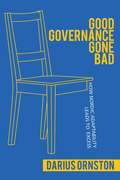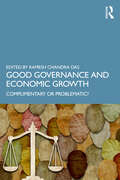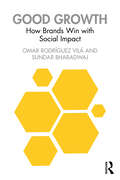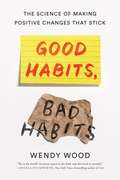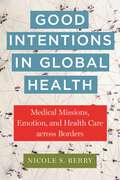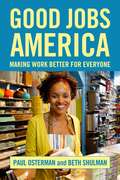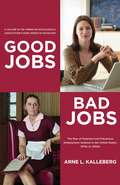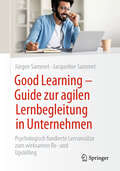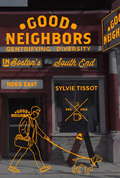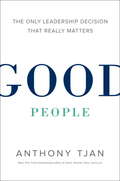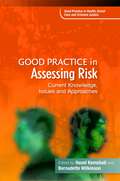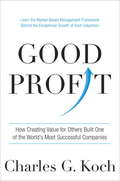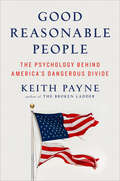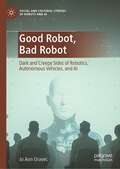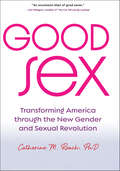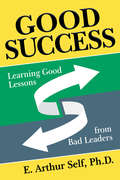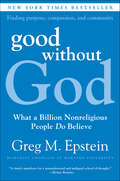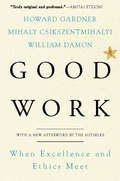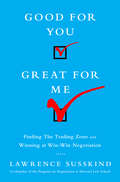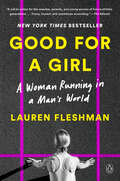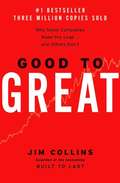- Table View
- List View
Good Governance Gone Bad: How Nordic Adaptability Leads to Excess (Cornell Studies in Political Economy)
by Darius OrnstonIf we believe that the small, open economies of Nordic Europe are paragons of good governance, why are they so prone to economic crisis? In Good Governance Gone Bad, Darius Ornston provides evidence that adapting flexibly to rapid, technological change and shifting patterns of economic competition may be a great virtue, but it does not prevent countries from making strikingly poor policy choices and suffering devastating results. Home to three of the "big five" financial crises in the twentieth century, Nordic Europe in the new millennium has witnessed a housing bubble in Denmark, the collapse of the Finnish ICT industry, and the Icelandic financial crisis.Ornston argues that the reason for these two seemingly contradictory phenomena is one and the same. The dense, cohesive relationships that enable these countries to respond to crisis with radical reform render them vulnerable to policy overshooting and overinvestment. Good Governance Gone Bad tests this argument by examining the rise and decline of heavy industry in postwar Sweden, the emergence and disruption of the Finnish ICT industry, and Iceland’s impressive but short-lived reign as a financial powerhouse as well as ten similar and contrasting cases across Europe and North America. Ornston demonstrates how small and large states alike can learn from the Nordic experience, providing a valuable corrective to uncritical praise for the "Nordic model."
Good Governance and Economic Growth: Complimentary or Problematic?
by Ramesh Chandra DasGovernance has been incorporated into the development models of many countries because of its role in ameliorating inequalities in society. This book explores whether good governance boosts or hinders economic growth with perspectives from countries like India, the USA, Nigeria, Turkey, Pakistan, Bangladesh, Nepal, and others, and on groups of developing nations like BRICS and ASEAN.Governance has twin roles within economic systems. The first is where it guides administrators and the second is the normative role where it may act as a stimulus to economic growth and development. With the help of empirical investigations, this book analyses the interrelationships between good governance and inclusive and sustainable economic growth, productive employment, political stability, and decent work for all. It assesses the impact of various governance indicators and policy strategies on the economy and the GDP of countries in the Global North and South. The book also focuses on roadblocks to good governance such as violent conflicts, corruption, international threats and crises and its implication on economic growth. This volume will be of interest to students and researchers of economics, political science, social science, international relations, public administration, and sociology.
Good Growth: How Brands Win with Social Impact
by Omar Rodriguez Vila Sundar BharadwajBusiness has a sustainability problem—and sustainability has a business problem, as many companies are fearful of engaging with social and environmental issues, owing to the costs and risks.Addressing these dual challenges head on, this book provides a blueprint for putting social and environmental benefits at the center of a company’s growth agenda. Many sustainability books offer 30,000-foot strategic views and broad-brush guidance on the business of “doing well by doing good,” but here is a ground-level guide for profitably integrating social and environmental benefits into individual products and brands. The book introduces the rapidly emerging phenomenon of social impact markets and shows how companies can capitalize on these new pockets of consumer demand through focused strategy, data-informed implementation, and a clear eye on the future, including how digital technologies are creating new ways for brands to expand their social impact and make social mission a central element of competitive strategy.Weaving together rich case studies and practical tools, this research-backed and real-world-ready guide fills a critical niche: a hands-on strategy playbook for the executives charged with driving brands’ top-line growth, making it essential reading for C-suite leaders, R&D, product, and brand managers, board members, NGOs, as well as MBA and executive education students.
Good Habits, Bad Habits: The Science of Making Positive Changes That Stick
by Wendy WoodA landmark book about how we form habits, and what we can do with this knowledge to make positive changeWe spend a shocking 43 percent of our day doing things without thinking about them. That means that almost half of our actions aren’t conscious choices but the result of our non-conscious mind nudging our body to act along learned behaviors. How we respond to the people around us; the way we conduct ourselves in a meeting; what we buy; when and how we exercise, eat, and drink—a truly remarkable number of things we do every day, regardless of their complexity, operate outside of our awareness. We do them automatically. We do them by habit. And yet, whenever we want to change something about ourselves, we rely on willpower. We keep turning to our conscious selves, hoping that our determination and intention will be enough to effect positive change. And that is why almost all of us fail. But what if you could harness the extraordinary power of your unconscious mind, which already determines so much of what you do, to truly reach your goals?Wendy Wood draws on three decades of original research to explain the fascinating science of how we form habits, and offers the key to unlocking our habitual mind in order to make the changes we seek. A potent mix of neuroscience, case studies, and experiments conducted in her lab, Good Habits, Bad Habits is a comprehensive, accessible, and above all deeply practical book that will change the way you think about almost every aspect of your life. By explaining how our brains are wired to respond to rewards, receive cues from our surroundings, and shut down when faced with too much friction, Wood skillfully dissects habit formation, demonstrating how we can take advantage of this knowledge to form better habits. Her clear and incisive work shows why willpower alone is woefully inadequate when we’re working toward building the life we truly want, and offers real hope for those who want to make positive change.
Good Intentions in Global Health: Medical Missions, Emotion, and Health Care across Borders (Anthropologies of American Medicine: Culture, Power, and Practice)
by Nicole S. BerryExplores informal global health action and the importance of intentions of those who volunteerIn the past two decades, medical missions have gained popularity among medical professionals, who view these excursions as important ethical interventions. Indeed, the notion of giving back by volunteering in rural or impoverished communities is celebrated as an ideal act of selflessness, one whose effects are unquestionably beneficial to those being served.Good Intentions in Global Health is a groundbreaking exploration of the growing realm of informal global health engagement, shedding light on the intricate interplay between intentions, emotions, and ethical considerations. Drawing on fieldwork in Guatemala, Nicole S. Berry investigates those who volunteer for short-term medical missions, revealing how the intent to do good shapes their everyday understandings of their own actions taken in the global health domain.Berry uncovers how the glorification of medical missions can obscure problems that stem from North American clinicians doctoring in places where they typically do not understand the context. The short-term nature of missions also means that volunteers are not privy to the long-term effects of their actions—the potential harms that may arise from a lack of sustained follow-up care or the utter absence of documentation that they were even there. By relying on gut instincts to reassure themselves that they are doing good, volunteers often bypass a comprehensive assessment of the ethical dimensions underlying their global health work.Good Intentions in Global Health shows why desires and emotions are increasingly important to contemporary global health. She makes the case that we must pay attention to volunteers’ perceptions of their work, however wrongheaded or naïve, in order to truly influence global health on the ground.
Good Jobs America
by Paul Osterman Beth ShulmanAmerica confronts a jobs crisis that has two faces. The first is obvious when we read the newspapers or talk with our friends and neighbors: there are simply not enough jobs to go around. The second jobs crisis is more subtle but no less serious: far too many jobs fall below the standard that most Americans would consider decent work. A quarter of working adults are trapped in jobs that do not provide living wages, health insurance, or much hope of upward mobility. The problem spans all races and ethnic groups and includes both native-born Americans and immigrants. But Good Jobs America provides examples from industries ranging from food services and retail to manufacturing and hospitals to demonstrate that bad jobs can be made into good ones. Paul Osterman and Beth Shulman make a rigorous argument that by enacting policies to help employers improve job quality we can create better jobs, and futures, for all workers. Good Jobs America dispels several myths about low-wage work and job quality. The book demonstrates that mobility out of the low-wage market is a chimera—far too many adults remain trapped in poor-quality jobs. Osterman and Shulman show that while education and training are important, policies aimed at improving earnings equality are essential to lifting workers out of poverty. The book also demolishes the myth that such policies would slow economic growth. The experiences of countries such as France, Germany, and the Netherlands, show that it is possible to mandate higher job standards while remaining competitive in international markets. Good Jobs America shows that both government and the firms that hire low-wage workers have important roles to play in improving the quality of low-wage jobs. Enforcement agencies might bolster the effectiveness of existing regulations by exerting pressure on parent companies, enabling effects to trickle down to the subsidiaries and sub-contractors where low-wage jobs are located. States like New York have already demonstrated that involving community and advocacy groups—such as immigrant rights organizations, social services agencies, and unions—in the enforcement process helps decrease workplace violations. And since better jobs reduce turnover and improve performance, career ladder programs within firms help create positions employees can aspire to. But in order for ladder programs to work, firms must also provide higher rungs—the career advancement opportunities workers need to get ahead. Low-wage employment occupies a significant share of the American labor market, but most of these jobs offer little and lead nowhere. Good Jobs America reappraises what we know about job quality and low-wage employment and makes a powerful argument for our obligation to help the most vulnerable workers. A core principle of U.S. society is that good jobs be made accessible to all. This book proposes that such a goal is possible if we are committed to realizing it.
Good Jobs, Bad Jobs: The Rise of Polarized and Precarious Employment Systems in the United States, 1970s-2000s
by Arne L. KallebergThe economic boom of the 1990s veiled a grim reality: in addition to the growing gap between rich and poor, the gap between good and bad quality jobs was also expanding. The postwar prosperity of the mid-twentieth century had enabled millions of American workers to join the middle class, but as author Arne L. Kalleberg shows, by the 1970s this upward movement had slowed, in part due to the steady disappearance of secure, well-paying industrial jobs. Ever since, precarious employment has been on the rise—paying low wages, offering few benefits, and with virtually no long-term security. Today, the polarization between workers with higher skill levels and those with low skills and low wages is more entrenched than ever. Good Jobs, Bad Jobs traces this trend to large-scale transformations in the American labor market and the changing demographics of low-wage workers. Kalleberg draws on nearly four decades of survey data, as well as his own research, to evaluate trends in U.S. job quality and suggest ways to improve American labor market practices and social policies. Good Jobs, Bad Jobs provides an insightful analysis of how and why precarious employment is gaining ground in the labor market and the role these developments have played in the decline of the middle class. Kalleberg shows that by the 1970s, government deregulation, global competition, and the rise of the service sector gained traction, while institutional protections for workers—such as unions and minimum-wage legislation—weakened. Together, these forces marked the end of postwar security for American workers. The composition of the labor force also changed significantly; the number of dual-earner families increased, as did the share of the workforce comprised of women, non-white, and immigrant workers. Of these groups, blacks, Latinos, and immigrants remain concentrated in the most precarious and low-quality jobs, with educational attainment being the leading indicator of who will earn the highest wages and experience the most job security and highest levels of autonomy and control over their jobs and schedules. Kalleberg demonstrates, however, that building a better safety net—increasing government responsibility for worker health care and retirement, as well as strengthening unions—can go a long way toward redressing the effects of today’s volatile labor market. There is every reason to expect that the growth of precarious jobs—which already make up a significant share of the American job market—will continue. Good Jobs, Bad Jobs deftly shows that the decline in U.S. job quality is not the result of fluctuations in the business cycle, but rather the result of economic restructuring and the disappearance of institutional protections for workers. Only government, employers and labor working together on long-term strategies—including an expanded safety net, strengthened legal protections, and better training opportunities—can help reverse this trend. A Volume in the American Sociological Association’s Rose Series in Sociology.
Good Jobs, Bad Jobs: The Rise of Polarized and Precarious Employment Systems in the United States, 1970s-2000s (A Volume in the American Sociological Association's Rose Series in Sociology)
by Arne L. KallebergToday, the polarization between workers with higher skill levels and those with low skills and low wages is more entrenched than ever. Good Jobs, Bad Jobs traces this trend to large-scale transformations in the American labor market and the changing demographics of low-wage workers. Kalleberg draws on nearly four decades of survey data, as well as his own research, to evaluate trends in U.S. job quality and suggest ways to improve American labor market practices and social policies. Good Jobs, Bad Jobs provides an insightful analysis of how and why precarious employment is gaining ground in the labor market and the role these developments have played in the decline of the middle class.
Good Leaders Learn: Lessons from Lifetimes of Leadership
by Gerard SeijtsHow do leaders learn to lead? How do leaders set themselves up for success? This book explores the real-life experiences of a wide variety of leaders from different industries, sectors, and countries to bring to light new lessons on the importance of life-long learning. Consisting primarily of a series of probing interviews, Good Leaders Learn presents the challenges, triumphs, and reflections of 31 senior and high-profile leaders, offering insight into how they learned to lead during their careers. The book pulls important and useful perspectives into a robust theoretical framework that includes the importance of innate curiosity, challenging oneself, risk-taking, and other key elements of good leadership. With practical insights complemented by the latest leadership research and theory, this book will help current and potential leaders to build a solid foundation of the leadership qualities vital to their continuing success.
Good Learning - Guide zur agilen Lernbegleitung in Unternehmen: Psychologisch fundierte Lernansätze zum wirksamen Re- und Upskilling
by Jürgen Sammet Jacqueline SammetGood Learning - kontinuierliches Lernen und gezielte Kompetenzentwicklung - mit agiler Lernbegleitung zu wirksamem Re- und UpskillingDurch konsequente Fort- und Weiterbildung gelingt die Anpassung an die sich immer schneller wandelnden Anforderungen. Doch viele Lerntrends halten nicht, was sie versprechen und versanden wirkungslos.Fern von flüchtigen Moden vermittelt Ihnen dieses Buch bewährte, wissenschaftlich fundierte Lernansätze. Erfahren Sie, wie Sie mit dem Konzept der Agilen Lernbegleitung die drei entscheidenden E`s im betrieblichen Lernen umsetzen: Effektivität, Effizienz und Empowerment.Dieses Buch vermittelt Ihnen handfeste Anwendungsideen für eine zeitgemäße Learning Experience. Damit „Good Learning“ gelingt. Zielgruppen:HR-Verantwortliche, die innovative Lernstrategien implementieren möchten.Learning Professionals, die nachhaltige Lernkulturen schaffen wollen.Trainer:innen, die ihre Angebote an die moderne Lernlandschaft anpassen möchten.Führungskräfte, die die Entwicklung der Mitarbeitenden zielgerichtet unterstützen wollen.Teammitglieder, die für das Team-Lernen verantwortlich sind.Fachexpert:innen, die ihre Expertise weitergeben möchten.
Good Neighbors
by David Broder Sylvie Tissot Catherine RomatowskiDoes gentrification destroy diversity? Or does it thrive on it? Boston's South End, a legendary working-class neighborhood with the largest Victorian brick row house district in the United States and a celebrated reputation for diversity, has become in recent years a flashpoint for the problems of gentrification. It has born witness to the kind of rapid transformation leading to pitched battles over the class and race politics throughout the country and indeed the contemporary world. This subtle study of a storied urban neighborhood reveals the way that upper-middle-class newcomers have positioned themselves as champions of diversity, and how their mobilization around this key concept has reordered class divisions rather than abolished them.From the Hardcover edition.
Good People: The Only Leadership Decision That Really Matters
by Anthony TjanGood people are your organization’s most critical asset. But what does it really mean to be good?Leaders love to say that any company is only as good as its people, but tend to evaluate candidates and employees more by their measurable accomplishments than by their “softer” qualities, like integrity, compassion, and other values. Bestselling author Anthony Tjan is leading a movement to change the way we think about goodness so that we can become better judges of people and create more goodness in ourselves, in others, and in our organizations. Tjan argues that while competence is necessary, real goodness must also encompass values; a fantastic résumé can never compensate for mediocre character. In Good People, he provides a clear language to discuss goodness, redefining it as a lifelong, proactive commitment that, like any skill, can be exercised, honed, and taught. When leaders prioritize goodness in themselves and in others, they can create lasting cultures and tremendous value. Drawing from his own experiences as an entrepreneur and venture capitalist, Tjan also taps into the wisdom of his relationships and interviews with extraordinary innovators, executives, artists, academics, teachers, and role models from all disciplines and walks of life. The cases and profiles shared include: Harvard Business School Dean Nitin Nohria, who has called for balancing leadership of competency with leadership of character; Supreme Court Justice Sonia Sotomayor, who has never forgotten her roots and shows profound kindness to her staff and clerks; Hollywood talent manager Shep Gordon, who has counseled his clients on the importance of generosity and gratitude; legendary venture capitalist Henry McCance, whose success proves that humbly ceding the spotlight to others makes room for their greatness; and master jazz musician Clark Terry, who devotedly mentored the young, blind pianist Justin Kauflin. Packed with practical yet often surprising advice, Good People establishes a new language and framework you can use to evaluate, develop, and lead with goodness. Tjan will convince you that there is a hard truth in the “soft stuff” of business, and that choosing and working well with good people is truly the only leadership decision that really matters.
Good Practice in Assessing Risk
by Bernadette Wilkinson Edited by Hazel KemshallMaintaining a balance between managing and assessing risk and upholding the required high standards of practice in health and social care can be demanding, particularly in the current climate of increased preoccupation with the difficult tensions between rights, protection and risk-taking. Good Practice in Assessing Risk is a comprehensive guide to good practice for those working with risk, covering a wide variety of health, social care and criminal justice settings including child protection, mental health, work with sex offenders and work with victims of domestic violence. The contributors discuss a range of key issues relating to risk including positive risk-taking, collaborating with victims and practitioners in the design of assessment tools, resilience to risk, and defensibility. The book also explores the role of bureaucracy in hindering high quality professional practice, complex decision-making in situations of stress or potential blame, and involving service users in assessment. This book reflects the latest policy and practice within health, social care and criminal justice and will be an invaluable volume to all professionals working in these fields.
Good Profit: How Creating Value for Others Built One of the World's Most Successful Companies
by Charles G. KochTHE UNIQUE MANAGEMENT SYSTEM FROM A LEGENDARY CEOIn 1967, Charles Koch took the reins of his father’s company and began the process of growing it from a $21 million start-up into a global corporation with revenues of about $115 billion, according to Forbes. So how did this MIT engineer manage grow Koch Industries into one of the largest private companies in the world today with growth exceeding that of the S&P 500 by almost 30-fold over the last five decades? Through his unique five-dimensional management process and system called Market-Based Management. Based on five decades of cross-disciplinary studies, experimental discovery, and practical implementation across Koch companies and their 100,000 employees worldwide, the core objective of Market-Based Management’s framework is as simple as it is effective: to generate good profit. What is good profit? Good profit results when a company creates value for customers in a way that helps them improve their lives. Good profit is the result of innovations that customers freely vote for with their own dollars; it’s the result of business decisions that create long term value for everyone--customers, employees, shareholders, and society.While you won't find the Koch Industries name on your home’s stain-resistant carpet, your baby’s more comfortable but absorbent diapers your stretch denim jeans, or your television with a better clarity screen, MBM™ drove these innovations and many more. Here, drawing on revealing, honest stories from his five decades in business – the company’s many successes as well as its stumbles – Koch walks the reader step-by-step through the five dimensions of Market-Based Management to show stockholders, entrepreneurs, leaders, students -- and innovators, supervisors and employees of all kinds, in any field --how to apply the principles to generate Good Profit in their organizations, companies, and lives.From the Hardcover edition.
Good Reasonable People: The Psychology Behind America's Dangerous Divide
by Keith Payne&“An eye-opening analysis of why our politics have become so polarized….Keith Payne illuminates one of the biggest problems of our time and lights the way toward some promising solutions.&” —Adam Grant, #1 New York Times bestselling author of Think Again "Good Reasonable People challenges each of us to drop the weapon of demonization and replace it with something more powerful: a framework for understanding—and for being understood by—people who see the world differently from us." —Margot Lee Shetterly, #1 New York Times bestselling author of Hidden FiguresA leading social scientist explains the psychology of our current social divide and how understanding it can help reduce the conflicts it causesThere has been much written about the impact of polarization on elections, political parties, and policy outcomes. But Keith Payne&’s goal is more personal: to focus on what our divisions mean for us as individuals, as families, and as communities. This book is about how ordinary people think about politics, why talking about it is so hard, and how we can begin to mend the personal bonds that are fraying for so many of us.Drawing upon his own research and his experience growing up in a working class, conservative Christian family in small town Kentucky, Payne argues that there is a near-universal human tendency to believe that people who are different from us are irrational or foolish. The fundamental source of our division is our need to flexibly rationalize ideas in order to see ourselves as good people. Understanding the psychology behind our political divide provides clues about how we can reduce the damage it is causing. It won&’t allow us to undo our polarization overnight, but it can give us the tools to stop going around in circles in frustrating arguments. It can help us make better choices about how we engage in political debates, how policy makers and social media companies deal with misinformation, and how we deal with each other on social media. It can help us separate, if we choose to, our political principles from our personal relationships so that we can nurture both.
Good Relationships in Schools: Teachers, Students, and the Epistemic Aims of Education (Kindheit – Bildung – Erziehung. Philosophische Perspektiven)
by Monika PlatzThe relationship between teacher and student is an important element of school education and as such irreplaceable: If we want schools to be good places for those who teach and learn there, we must make sure that the educational relationships between teachers and students are good, too.In research about school education, surprisingly little attention is paid to the normative dimension of the relationship between teacher and student. This lacuna points to a desideratum in the philosophy of education: More should be said about the normative structure of the teacher-student relationship, its role in teaching and learning, and its final value for teacher and student.Answering these fundamental philosophical questions is the core of this book. It offers a normatively rich concept of a good teacher-student relationship that is based on the analysis of two major relationship goods: trust and care. Moreover, the book explains the instrumental value of a good educational relationship for the student’s achievement of epistemic aims of school education as well as the final value of such a relationship for teacher and student.
Good Robot, Bad Robot: Dark and Creepy Sides of Robotics, Autonomous Vehicles, and AI (Social and Cultural Studies of Robots and AI)
by Jo Ann OravecThis book explores how robotics and artificial intelligence (AI) can enhance human lives but also have unsettling “dark sides.” It examines expanding forms of negativity and anxiety about robots, AI, and autonomous vehicles as our human environments are reengineered for intelligent military and security systems and for optimal workplace and domestic operations. It focuses on the impacts of initiatives to make robot interactions more humanlike and less creepy (as with domestic and sex robots). It analyzes the emerging resistances against these entities in the wake of omnipresent AI applications (such as “killer robots” and ubiquitous surveillance). It unpacks efforts by developers to have ethical and social influences on robotics and AI, and confronts the AI hype that is designed to shield the entities from criticism. The book draws from science fiction, dramaturgical, ethical, and legal literatures as well as current research agendas of corporations. Engineers, implementers, and researchers have often encountered users' fears and aggressive actions against intelligent entities, especially in the wake of deaths of humans by robots and autonomous vehicles. The book is an invaluable resource for developers and researchers in the field, as well as curious readers who want to play proactive roles in shaping future technologies.
Good Sex: Transforming America through the New Gender and Sexual Revolution
by Catherine M. RoachThe United States may have a puritanical past, but the 21st century is wide open to diverse gender expression and romance. Good Sex is the manifesto—or Manisexto, if you will—for this cultural revolution. Same-sex marriage is legal, the #MeToo movement has exploded, colleges nationwide now teach consent-based sexual health, the media celebrates body positivity, and transgender visibility has become mainstream. Defining "good sex" as both ethical and pleasurable, Catherine M. Roach features such topics as equity, intersectionality, and shared pleasure while offering a lively discussion that is inclusively feminist, queer-friendly, and sex-positive without being divisive.An accessible guidebook, Good Sex provides hope that America's sexual, gender, and racial injustices can be addressed together. After all, this new gender and sexual revolution strengthens the pursuit of happiness and love. Welcome to the revolution!
Good Success: Learning Good Lessons from Bad Leaders
by E. Arthur SelfThe purpose of Good Success is to help readers learn and integrate into their life and career the good lessons learned from bad leaders. Bad leaders drive organizational dysfunction, incarnate indecision, and deplete personal energy and team resolve. Also, bad leaders exhaust resources and hope. But, through Good Success readers gain the knowledge and the lessons to overcome the damage, shape their awareness, and build new courage to navigate beyond the chaos. Good Success enable recovery from the effects of bad leadership, creates the means to achieving self-mastery, brings closure to previous negative circumstances, and so much more. It is possible that those who work for bad leaders have already written-off any chance of benefiting from the chaos that they create. If so, Good Success helps readers draw a valuable inheritance from the F.E.A.R. (failures, experiences, anxieties, roadblocks) they’ve seen bad leaders produce.
Good Without God: What a Billion Nonreligious People Do Believe
by Greg EpsteinA provocative and positive response to Christopher Hitchens, Sam Harris, Richard Dawkins, and other New Atheists, Good Without God makes a bold claim for what nonbelievers do share and believe. Author Greg Epstein, the Humanist chaplain at Harvard, offers a world view for nonbelievers that dispenses with the hostility and intolerance of religion prevalent in national bestsellers like God is Not Great and The God Delusion. Epstein’s Good Without God provides a constructive, challenging response to these manifestos by getting to the heart of Humanism and its positive belief in tolerance, community, morality, and good without having to rely on the guidance of a higher being.
Good Work: When Excellence and Ethics Meet
by Howard GardnerWhat does it mean to carry out "good work"? What strategies allow people to maintain moral and ethical standards at a time when market forces wield unprecedented power and work life is being radically altered by technological innovation? These are the questions at the heart of this important collaboration by three leaders in psychology. Enlivened with stories of real people facing hard decisions, Good Work offers powerful insight into one of the most important issues of our time and, indeed, into the future course of science, technology, and communication.
Good for You, Great for Me: Finding the Trading Zone and Winning at Win-Win Negotiation
by Lawrence Susskind"Win-win" negotiation is an appealing idea on an intellectual level: Find the best way to convince the other side to accept a mutually beneficial outcome, and everyone gets their fair share. The reality, though, is that people do not want a fair share; they want to win. Tell your boss that you concocted a deal where your company got its piece of the pie, and the reaction is likely to be: "Maybe we need to find someone harder-nosed than you who knows how to win." However, to return to an earlier era before "win-win" negotiation was in fashion and seek simply to dominate or bully grudging opponents into submission would be a step in the wrong direction- and a public relations disaster.Into this dilemma steps renowned expert Lawrence Susskind with a brilliant new negotiation paradigm he calls "the trading zone." Good for You, Great for Me provides the missing operational guidelines for winning negotiations in business, family disputes, international relations, or public affairs without undermining trust or ruining relationships. It provides not just new principles but new tools- six operational steps to take after you've found your way into the trading zone- to ensure you get as large a share of the pie as possible.Good for You, Great for Me also provides guidance for handling special situations such as dealing with huge power differentials (the 900 pound gorilla), liars, and irrational people; the addition of lots more parties to the negotiation; a history of bad relationships; negotiating when the relationship is too important to lose; and trying to make deals in cross-cultural situations.
Good for a Girl: A Woman Running in a Man's World
by Lauren Fleshman* A New York Times Bestseller * Winner of the William Hill Sports Book Of The Year Award* A Financial Times Best Sports Book of 2023Fueled by her years as an elite runner and advocate for women in sports, Lauren Fleshman offers her inspiring personal story and a rallying cry for reform of a sports landscape that is failing young female athletes&“Women&’s sports have needed a manifesto for a very long time, and with Lauren Fleshman&’s Good for a Girl we finally have one.&” —Malcolm Gladwell, author of Outliers and David and GoliathLauren Fleshman has grown up in the world of running. One of the most decorated collegiate athletes of all time and a national champion as a pro, she was a major face of women&’s running for Nike before leaving to shake up the industry with feminist running brand Oiselle and now coaches elite young female runners. Every step of the way, she has seen the way that our sports systems—originally designed by men, for men and boys—fail young women and girls as much as empower them. Girls drop out of sports at alarming rates once they hit puberty, and female collegiate athletes routinely fall victim to injury, eating disorders, or mental health struggles as they try to force their way past a natural dip in performance for women of their age.Part memoir, part manifesto, Good for a Girl is Fleshman&’s story of falling in love with running as a girl, being pushed to her limits and succumbing to devastating injuries, and daring to fight for a better way for female athletes. Long gone are the days when women and girls felt lucky just to participate; Fleshman and women everywhere are waking up to the reality that they&’re running, playing, and competing in a world that wasn&’t made for them. Drawing on not only her own story but also emerging research on the physiology and psychology of young athletes, of any gender, Fleshman gives voice to the often-silent experience of the female athlete and argues that the time has come to rebuild our systems of competitive sport with women at their center.Written with heart and verve, Good for a Girl is a joyful love letter to the running life, a raw personal narrative of growth and change, and a vital call to reimagine sports for young women.
Good to Great: Why Some Companies Make The Leap ... And Others Don't
by Jim CollinsStudies several companies to determine why some failed, some were good, but a very few were great. Suggests that good is the enemy of great and that there are solid factors which can be identified to show why the great are where they are. This is one of the few business books based on broad quantitative research rather than small case studies. This book contains many graphs and figures which have been briefly described. It also has notes at the end of the book which are references indicated by numbers in the text. A couple appendices and the index had formatting which is too complex to recreate as text only. The main body of the book and most appendices should be excellent
Goodbye Eastern Europe: An Intimate History of a Divided Land
by Jacob Mikanowski'Do not rush to bid farewell to eastern Europe until reading this book. Meticulously researched and beautifully written, this very personal story of the place that one can&’t find on the map pays tribute to the origins of the experiences, cultures and ideas that continue to shape political and ideological battles of the modern world.' Serhii Plokhy Eastern Europe is more than the sum total of its annexations, invasions and independence declarations. From the Baltics to the Balkans, from Prague to Kiev, the area exuded a tragicomic character like no other. This is a paean for a disappearing world of movable borders, sacred groves and syncretism. And an invitation to not forget.
